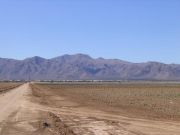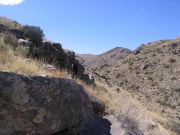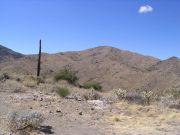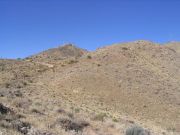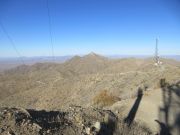
The Mountains of Arizona
• www.surgent.net
|
|
Barry Goldwater Peak |
• Highpoint: White Tank Mountains • Maricopa County |
|
Date: February 19, 2006 • Elevation: 4,083 feet • Prominence: 2,503 feet • Distance: 11 miles • Time: 6 hours • Gain: 2,400 feet • Conditions: Breezy with intermittent clouds and sun • Teammates: Pete Bengtson The White Tank Mountains lie west of Phoenix, forming the western "wall" of the Valley of the Sun, as Phoenix and its suburbs likes to call itself. The range is about 25 miles west of the main city, and is itself a long range, stretching about fifteen miles north to south. The summit of the White Tank Mountains is a bump along the ridgeline at 4,083 feet elevation. From the Phoenix side, it's not obvious which bump is the highest point. A much bigger and blockier summit with about a hundred towers on it seems to be higher. The range highpoint is more apparent when viewed from the vacant west side. The summit is now known as Barry Goldwater Peak. Most of the White Tank Mountains are enclosed within the White Tank Mountains Regional Park, with access from Olive Avenue. This park has many parking spots, hiking trails, horse trails, day-use ramadas and camping spots. The trail network is extensive, but none "officially" go to the summit. The main attraction are tanks, called tinajas, which are natural depressions in the rock that hold water into the hottest parts of summer. The ancient Hohokam Indians encamped in these hills until about 1100, and petroglyphs can be found as well as evidence of old "check dams" built by these long-ago peoples to capture water. I moved to Arizona in 1992, and later that summer, when temperatures moderated, I explored the park. I hiked one trail a mile or two, then hiked back, with no real plan in mind. I was also here for pleasure in 1998, then a few times for rescues (and one body recovery) while with the Sheriff's Mountain Rescue Team during the period between 1999-2003. However, it was not until now, early 2006, that I would try to hike to the highest point. Accompanying me would be Peter Bengtson from Tucson. I did some cursory study of the trails before the hike, but no information about actually getting to the summit existed anywhere on the internet or in print. It appeared we'd have to bushwhack a long stretch of this hike. Furthermore, rangers explicitly discourage hikers from "visiting the towers". These are the bigger grouping of towers that are lower in elevation from the summit. I met Pete alongside Olive Avenue early this morning, just outside the park boundary. We paid our fees and drove to the Mesquite Canyon Trailhead, starting our hike about 7:30 a.m. in cool, pleasant conditions. We walked past the informational sign to the Mesquite Trail, which goes left. Quickly, the trail enters into a canyon and makes a few switchbacks up the hillsides, and before we knew it we were a couple hundred feet above our cars. The trail crosses a drainage at a "Trail Closed" sign (it refers to a side trail). From here, the real trail climbs over a ridge, then down the other side slightly, trending generally west. Here, we had the first glimpse of the pointed summit off on the highest ridge. At 1.8 miles (said a sign), we came to the Willow Trail junction. We stayed straight and on the Mesquite Trail. The trail bends south, then west again, going up and down over a series of low hills and outcrops, then starts up a steep section that topped out on a small ridge, roughly 2.5 miles from the cars. Here, I stopped and let Pete catch up. All the while a group of six was gaining on us, talking loudly. We all congregated on the top of this little ridge. The group of six continued down and away on the trail, while we got antsy and figured we should leave the trail and start our cross-country segment. This proved to be a bad idea. We left the trail and made our way up the slopes toward the prominent ridge that led to the top. Game paths helped in places but most of it was brushy and rocky. We got to the ridge ... and saw the trail again, the same Mesquite Trail we had been on moments earlier. This little sojourn cost us just 20 minutes of our time. Finally, the trail led to a junction with the Ford Canyon and Goat Camp trails, 3.2 miles from the trailhead. We went left on the Goat Camp Trail for about a mile, a well-maintained route high on the rounded ridges. With no rocky obstacles to slow us, this was an enjoyable portion of the hike. The trail topped out on the ridge west of a point marked as elevation 3,185 feet on the map, near a jeep track. I stopped here, had a bite and waited for Pete, about five minutes behind me. We rested then started cross-country again. Quickly we discovered the old jeep track, which was barely recognizable. It offered a reasonably brush-free route, but all the while I was amazed that someone thought this a good place to drive a Jeep. The tracks were steep and cambered outward from the hillside. I can't imagine it's been driven in at least 40 years, but for hiking purposes, it was dandy. In less than a mile on the Jeep track, we had come upon the major dirt road that goes north-south through the range. The road sees vehicles as we saw plenty of tracks, but on this day all was quiet. Frankly, I'm not sure how aggressively this area is patrolled and if it's even "illegal" to be here. We saw not a single sign about trespassing. The only thing I could think of was that Luke Air Force Base had some sensitive locations up here. But if that was the case, I doubt they'd put something up there without massive fencing and armed sentries guarding it. The walk up the remaining segment of road went easy and fast, and we summitted at 11:30 in pleasant, slightly breezy conditions. We took a 30-minute lunch break up top. The views down were nice, barring those blocked by the towers. Looking west we had wide-open deserts, with Harquahala Mountain to the northwest. To the east we could see the farms and suburbs of Phoenix, with the downtown buildings barely visible. The Sierra Estrellas rose to the southeast. North and south we saw just more of the White Tank range. We signed in the log, noting it was placed there in 1988 and still the booklet was only half-full. We recognized many of the names as fellow hikers we know. The hike back went quickly, knowing now to stay on the Mesquite Trail all the way back to our cars. We saw no one until we were back on the Mesquite Trail, and then only just a few people. As we got closer to the cars, much more people were hiking. I passed a lot going down, then almost back at the parking lot, a kind woman mentioned that I had a tear in my pants and my undies were showing for all to see. Slightly embarrassed (and bare assed, sort of), I walked out, changed into drier clothes, threw out the pants, and waited again for Pete. We had a good chat and shook hands, then went on our separate ways back to our respective homes. The hike out took me about 2 hours. The total stats worked out to about 11 miles round trip and 2,400 feet of gain, all on trail, old road and new road, plus our unintended off-route section. A nice hike, and one I am surprised I hadn't done before in my 14 years of living here. |
|
